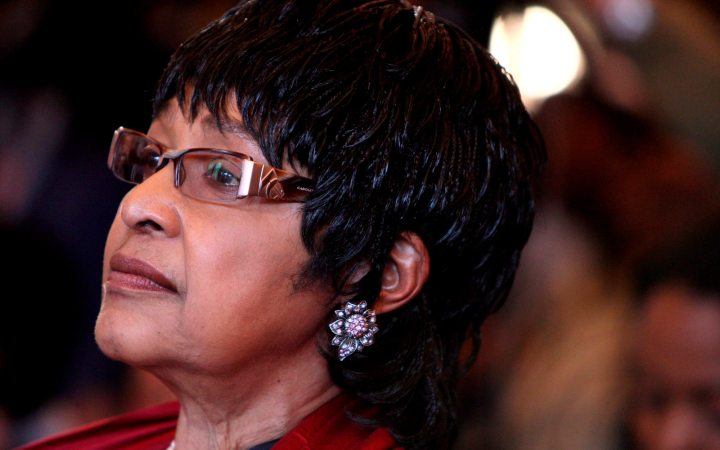Media, South Africa, World
Op-Ed: Musing on the Western media portrayal of Winnie Madikizela-Mandela

Barely 24 hours after Winnie Madikizela-Mandela’s death, the Western media got to work and put the necessary mechanism in place to undermine her legacy. Its verdict? Mama Winnie should be dismissed as an embarrassing, evil, angry mugger. By AHMED SULE.
Western media powerhouses like the BBC, The Economist, New York Times, the Independent and the Financial Times have seized the opportunity of Mama Winnie’s death to focus on the big “but”.
When I turned to the BBC on the day of her death, I watched the speeches made by some officials of the ANC, her grandson and a Methodist preacher. After the speeches, images of Mama Winnie appeared on the screen and the broadcaster showed a video clip of her pushing a white woman, after which they showed a video of her being rebuffed by former South African President Thabo Mbeki after she tried to greet him. The voice-over stated that she was a controversial figure.
Later on, the newscaster interviewed Nelson Mandela’s goddaughter, Tanya von Ahlefeldt, who spoke about Mama Winnie in less than glowing terms, focusing mainly on her flaws.
The Economist in its obituary titled “Winnie Madikizela-Mandela leaves behind a complicated legacy” carried out a comparative analysis between Mama Winnie and Nelson Mandela. The magazine described Mandela as a saint, while Mama Winnie was described as a “brave woman who went bad”.
The periodical claimed that in contrast to Mandela’s famed forgiveness, Mama Winnie’s seething anger came to define her.
In the London Evening Standard, Peter Hain, the British Labour Party politician, wrote that the strain of being a hero’s (Mandela) wife exposed her flaws. According to Hain, she was heroic, spirited and courageous, “but ultimately flawed”.
The Independent was less diplomatic in its headline, “From Mother of the nation to mugger”. Following the line of The Economist, it did a comparative analysis between Mama Winnie and Nelson Mandela, describing the former as an embarrassment and the latter as the world’s most revered statesman.
The Financial Times’ African Editor, David Pilling, noted in his opening line:
“If Nelson Mandela was the saint of the anti-apartheid movement, Winnie Madikizela-Mandela, his wife of 38 years who has died at the age of 81, was its fallen angel.”
He wrote that unlike Nelson Mandela, who was a symbol of reconciliation and forgiveness, Mama Winnie was an “uncomfortable flag bearer for continuing black anger against a post-apartheid settlement”.
A few hours after her demise, the New York Times paid tribute to her by writing in its opening paragraph:
“Winnie Madikizela-Mandela, whose hallowed place in the pantheon of South Africa’s liberators was eroded by scandal over corruption, kidnapping, murder and the implosion of her fabled marriage to Nelson Mandela, died early Monday in Johannesburg.”
The American newspaper stated that she resented “the notion that her anti-apartheid credentials had been eclipsed by her husband’s global stature and celebrity”.
A couple of hours later, the New York Times published another article using a headline similar to that of the Independent: “Winnie Mandela, ‘Mother’, Then ‘Mugger’, of New South Africa.”
Admittedly, like most of us, Mama Winnie was not without blemish. She made her fair share of mistakes. However, these flaws shouldn’t be used as an excuse to diminish her contribution towards making the world a better place.
Mama Winnie was a pillar of support for Mandela during his Long Walk to Freedom. For 27 years, she became the public face of his struggle and played a crucial role in drumming up local and international support for the fight against apartheid when Mandela and his colleagues were imprisoned. She endured hardship from the apartheid apparatus. She was subjected to 491 days in solitary confinement, denied access to her husband and sent into exile. Despite these setbacks, her commitment to the cause remained unrelenting.
Whenever the names of South African Freedom Fighters’ Hall of Fame inductees are read out, Winnie Madikizela-Mandela’s name should and must be mentioned in the same sentence as the names of other icons such as Steve Biko, Albert Luthuli, Walter Sisulu , Oliver Tambo and Nelson Mandela.
A key reason why the white media refuses to acknowledge Mama Winnie is because she is a strong black woman. The white supremacist power structure has always been uncomfortable with the image of confident black women like Serena Williams, Angela Davis, Diane Abbott or Winnie Madikizela-Mandela.
The white world has historically dehumanised black women as brutes. When white supremacy comes into contact with women who don’t fit this stereotype, it clutches at straws and amplifies what it views as a weak spot. The white world has not forgiven or forgotten Mama Winnie’s role in the dismantling of the last stronghold of colonialism in Africa.
The use of the terms “anger” and “angry” by The Economist and the Financial Times is a rehash of the white supremacist narrative of the so-called angry black woman. The white power structure is hostile to the idea of a black woman leading except when she is subservient to whiteness. It has no issues in celebrating the white feminist, but when a black woman takes charge, she is dismissed as an angry black woman.
Mama Winnie was the embodiment of blackness. She was brave, brainy, beautiful, and black. She wore her blackness as a badge of honour. Her afro, head wraps, traditional clothes, braids and beads made the apartheid regime and its Western supporters uncomfortable.
As she grew older, she refused to slow down on her agitation, thus making it difficult for whiteness to appropriate her. The Western media’s dismissal of Mama Winnie as the erratic jealous wife of Nelson Mandela and its refusal to acknowledge her as an individual also plays into the white supremacist narrative that the black woman is incapable of having an identity distinct from the black man.
The demonisation of Mama Winnie’s legacy by the Western media is nothing new. The white power structure has resulted to two tactics to strip black heroes and activists of their potency: it either “blackwashes” them as demons or “whitewashes” them as saints.
Mama Winnie both in life and in death has been put into the demon category. Since the white structure controls the media, it can easily manipulate the imagery to project a black activist as evil. By creating a monster out of the black activist, the white supremacist’s expectation is that over time, the listener or reader will ignore the message and be distracted by the so-called evil deeds of the messenger.
For instance, Malcolm X has been demonised by the white media and 53 years since his assassination the general narrative is Malcolm X was an angry black man who advocated hatred and violence. The same diversionary tactic has been applied to Marcus Garvey and Diane Abbott.
In contrast to the demonisation approach, the sainthood approach downplays the flaws and the militancy of the messenger, and overemphasis his/her sterling attributes. The messengers are in the words of Cornel West deodorised and Santa-Clausified for a white audience. The strategy has been applied to the likes of Nelson Mandela, Martin Luther King and Rosa Parks.
In the case of Nelson Mandela, his forgiveness and reconciliation with his oppressors has been overemphasised, while his opposition to apartheid and capitalism has been diluted.
For Martin Luther King, his advocacy against the triplet evil of racism, militarism and economic injustice has been ignored and he has been beatified into a colorblind dreamer who is quoted by white supremacist, military hawks, and corporate executives.
Rosa Park’s membership of the NAACP and her black activism has been covered, while we have been presented with the image of a seamstress who was too tired to stand up in the bus.
Once black activists have been classified into demons and saints, it then becomes easy for the West to play its oldest trick – Divide and Rule. The “saints” are used to airbrush the “demons”. Martin Luther King is to be remembered while Malcolm X is to be forgotten; Fredrick Douglas is to be celebrated while Marcus Garvey is to be ignored; Olusegun Obasanjo is to be respected while Patrice Lumumba is to be overlooked.
The Western media has now resurrected the forgiving, revered, reconciling Nelson Mandela so as to bury the troublesome, angry and embarrassing Mama Winnie. The end result is the same – maintain the white supremacist status quo.
In contrast to its treatment of Mama Winnie, the white power structure applies a different rule in celebrating its white supremacists. While the white media relishes in demonising black heroes, it overlooks the flaw of its white heroes. The West in general and the Western media in particular are oblivious to the fact that one man’s freedom fighter can be another woman’s terrorist.
While the Western media sees Winston Churchill as a war hero, it fails to see that in India he is viewed as a terrorist responsible for the murder of millions of starving Indians.
While Thomas Jefferson is seen in white America as the founding father of the country, they fail to see that in black America he is viewed as a slave owner; while Cecil Rhodes is seen by Westerners as a mining magnate, they fail to see that in Zambia, Zimbabwe and South Africa, he is viewed as a terrorist responsible for dehumanising blacks and looting the African continent.
In conclusion, the West’s reaction to Mama Winnie’s death should be a wakeup call for us. As the Western media metastasises throughout Africa and other black and brown regions of the world, we should be wary of outsourcing our history and heroes to the white media. If we don’t tell our own stories and celebrate our own heroes, we would end up whitewashing our heritage. DM
Ahmed is a CFA Charterholder, writer and social critic. He is based in London. He cites Jesus Christ, Martin Luther King, Malcolm X, Fela Anikulapo Kuti, Kwame Nkrumah, and Angela Davis as his major influences.
Photo: (File) South African former president Nelson Mandela’s ex-wife Winnie Madikizela-Mandela listens to a speech at the opening of the newly renovated Mandela House museum in Soweto, South Africa, 19 March 2009. Photo: EPA-EFE/Jon Hrusa

















 Become an Insider
Become an Insider